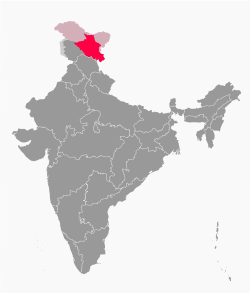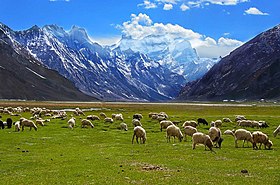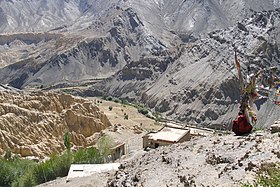Ladakh ("land of high passes") is a Union Territory in northern India. It is located between the Karakoram mountain range in the north and the main Himalayas to the south. Ladakh is well-known for its remote mountain scenery. It is inhabited by Tibetan people and Small Indo aryan population.[7] Their language is an archaic dialect of the Tibetan language. It is sometimes called "Little Tibet", because it has been strongly influenced by Tibetan culture. Ladakh is one of the least populated regions in the area.
Ladakh | |
|---|---|
 Ladakh in India (lighter shade indicated claimed but not controlled territories) | |
| Coordinates: 34°10′12″N 77°34′48″E / 34.17000°N 77.58000°E | |
| Country | |
| Union territory | 31 October 2019[1] |
| Capital | Leh,Kargil[2] Kargil[3] |
| Districts
1.Leh district-Leh 2.Kargil district-Kargil 3.Zanskar district-Padum 4.Drass district-Drass 5.Sham district-Likir 6.Nubra district-Diskit 7.Changthang district-Nyoma | 7 |
| Government | |
| • Body | Administration of Ladakh |
| • Lieutenant Governor | Radha Krishna Mathur |
| • Member of Parliament | Md.Hanifa (Independent) |
| • High Court | Jammu and Kashmir High Court |
| Area | |
| • Total | 59,146 km2 (22,836 sq mi) |
| Highest elevation | 7,742 m (25,400 ft) |
| Lowest elevation | 2,550 m (8,370 ft) |
| Population (2011) | |
| • Total | 274,289 |
| • Density | 4.6/km2 (12/sq mi) |
| Demonym | Ladakhi |
| Languages | |
| • Official: Ladakhi,hindi,english | Ladakhi, Kashmiri, Panjabi |
| Time zone | UTC+5:30 (IST) |
| Vehicle registration | LA[6] |
| Website | ladakh |
Ladakh region borders Tibet to the east, Lahaul and Spiti to the south, and Kashmir, Jammu and Baltistan to the west.
In the past, Ladakh was important for trade. It was where several important trade routes met.[8] However, China closed the border with Tibet in the 1960s, and since then, international trade has suffered. Tourism is an exception, and it has been very important for Ladakh's economy since about 1974. Because the wider region is a part of the Kashmir conflict, the Indian military has a strong presence in Ladakh.
The largest town in Ladakh is Leh. Ladakh's most population are followers of Shia Islam and rest majority is Buddhists which are 35%of population.[9] Leh is followed by Kargil as the second largest town in Ladakh.[10] Some Ladakhi activists have in recent times called for Ladakh to be made into a union territory because of its religious and cultural differences with Kashmir, which is mostly Muslim.[11][12] Under Jammu and Kashmir Reorganisation Act, 2019 Ladakh was declared as a separate union territory.
Districts/Divisions:
Indian government accounced new 5 districts(Nubra,Sham, Changthang, Zanskar,Drass) in Ladakh U.T. Ladakh has 2 divisions and 7 districts.
A.Leh division:
1.Changthang District - Nyoma,it has two tehsils:Durbuk and Nyoma
2.Sham District - Khaltsi,it has two tehsils:Likir and Khaltsi
3.Nubra District - Diskit 4.Leh District - Leh
4.Leh District - Leh,it has two tehsils:Leh and Karu
B.Kargil Division:
5.Zanskar District - Padum
6.Drass District - Drass
7.Kargil District - Kargil
Geography
changeLadakh is a high plateau. Much of it is over 3,000 m (9,800 ft) above sea level.[9] It spans the Himalayan and Karakoram mountain ranges and the upper Indus River valley. The Indus is the most important part of Ladakh for its people. Most major historical and current towns (Shey, Leh, Basgo and Tingmosgang) are located close to the Indus River. The stretch of the Indus flowing through Ladakh is the only part of this river in India, most of the river is in Pakistan. The river is sacred in Hindu religion and culture.
People and culture
changeLike the land itself, the people of Ladakh are generally quite different from those of the rest of India. The faces and physique of the Ladakhis, and the clothes they wear, are more akin to those of Tibet and Baltistan than of India. The original population may have been Dards, an Indo-Aryan race down from the Indus and the Gilgit area
About 46% are Buddhist by faith. Just over 47% are Muslim, and 6% are Hindu. Kargil District and Drass District is Muslim-majority and Leh, Changthang, Zanskar,Sham,Nubra District is Buddhist-majority within Ladakh. They traditionally lead a nomadic pastoral life. About 90% of them depend on agriculture based on the Indus River for their livelihood. Barley, wheat, buckwheat, peas, rapeseed and beans are the main agricultural products. Apples and apricots are grown in warmer regions of low altitude.
Another occupation of the people is sheep-rearing. The herdsmen are called Chang-pas. They rear long-haired goats and sheep from whose under-fleece the famous Kashmiri Pashmina shawls are made. Chang-pas live in tents and are nomadic, going from place to place in search of pastures. The people are keenly interested in trade. Wool, in raw form is their chief commercial product. The men travel long distances, seeking favourable prices for their wares, which consist of salt, dry fruits and cultured pearls and semi-precious stones. In return they get tea, tobacco, grain, sugar and other essential goods.
Playing polo on fast-racing ponies is the most popular entertainment in Ladakh, the game was introduced in Ladakh by the Balti emperor's of Makpon. The horse is not changed with each chukker (chukka) as in western style polo, but each player carries on with the same sturdy pony. Primitive wooden balls are still used for the game, played on a rough, uneven pitch whose popularity persists in Ladakh.
Ladakh offers the hunters exotic hunts of the markhor, ibex, red bear, snow leopard, wild sheep, antelope, gazelle and marmot. Ladakh is also rich in minerals like gold, copper and semi-precious
Flora and fauna of Ladakh
changeLadakh is also known as land of high passes in India. It has a greater diversity of animal and plants. Vegetation is extremely sparse in Ladakh except along streambeds and wetlands, on high slopes, and in irrigated places. The first European to study the wildlife of this region was Ferdinand Stoliczka, an Austrian-Czech palaeontologist, who carried out a massive expedition there in the 1870s.
The fauna of Ladakh has much in common with that of Central Asia in general and that of the Tibetan Plateau in particular. Exceptions to this are the birds, many of which migrate from the warmer parts of India to spend the summer in Ladakh. For such an arid area, Ladakh has a great diversity of birds — a total of 225 species have been recorded. Many species of finches, robins, redstarts (like the black redstart), and the hoopoe are common in summer. The brown-headed gull is seen in summer on the river Indus and on some lakes of the Changthang. Resident water-birds include the brahminy duck also known as the ruddy sheldrake and the bar-headed goose. The black-necked crane, a rare species found scattered in the Tibetan plateau, is also found in parts of Ladakh. Other birds include the raven, Eurasian magpie, red-billed chough, Tibetan snowcock, and chukar. The lammergeier and the golden eagle are common raptors here specially in Changthang region.
History
changeAt the Partition of India in 1949, the territory (then called Jammu and Kashmir) was split between India and Pakistan. India lost part of it to China as result of the Sino-Indian War, of 1962.
References
change- ↑ Ladakh has 59,146 km2 of area administered by India and 72,971 km2 of area controlled by Pakistan under Gilgit-Baltistan, which is claimed by India as part of Ladakh. Additionally, it has 5,180 km2 of area controlled by the People's Republic of China under Trans-Karakoram Tract and 37,555 km2 of area controlled by the People's Republic of China under Aksai Chin, which is claimed by India as part of Ladakh.
- ↑ "Archived copy" (PDF). Archived from the original (PDF) on 2019-08-09. Retrieved 2020-01-09.
{{cite web}}: CS1 maint: archived copy as title (link) - ↑ "Ladakh Gets Civil Secretariat". 17 October 2019.
- ↑ Excelsior, Daily (12 November 2019). "LG, UT Hqrs, Head of Police to have Sectts at both Leh, Kargil: Mathur". Retrieved 17 December 2019.
- ↑ "MHA.nic.in". MHA.nic.in. Archived from the original on 8 December 2008. Retrieved 21 June 2012.
- ↑ "Saltoro Kangri, India/Pakistan". peakbagger.com. Retrieved 9 August 2019.
- ↑ "Archived copy" (PDF). Archived from the original (PDF) on 2020-11-30. Retrieved 2020-01-09.
{{cite web}}: CS1 maint: archived copy as title (link) - ↑ Jina, Prem Singh (1996). Ladakh: The Land and the People. Indus Publishing. ISBN 978-81-7387-057-6.
- ↑ Rizvi, Janet (2001). Trans-Himalayan Caravans – Merchant Princes and Peasant Traders in Ladakh. Oxford India Paperbacks.
- ↑ 9.0 9.1 Rizvi, Janet (1996). Ladakh — Crossroads of High Asia. Oxford University Press.
- ↑ Osada et al (2000), p. 298.
- ↑ "Kargil Council For Greater Ladakh". The Statesman, 9 August 2003. 2003. Archived from the original on 2006-10-19. Retrieved 2006-08-22.
- ↑ Loram, Charlie (2004) [2000]. Trekking in Ladakh (2nd ed.). Trailblazer Publications. ISBN 9781873756751.


